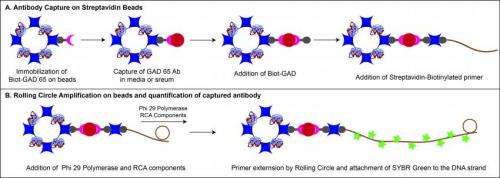A highly sensitive microsphere-based assay for early detection of Type I diabetes

A team of researchers from the Center for Engineering in Medicine at the Massachusetts General Hospital have developed a novel fluorescence-based assay for sensitive detection of antibodies within microliter volume serum samples. This new assay is at least 50 times more sensitive than the traditional radioimmunoassay (RIA), which is the gold standard currently used in the clinic.
This new technology is particularly attractive for immunological assays as it allows: 1) use of very small volumes of sample reagents (5 μL), and 2) use of traditional analytical systems such as a standard real time PCR requires much lower sample volumes than traditional ELISA methods allowing the modular bead-based assay to be modified for use in studies using small animal models, where the sample volume can be a limiting factor. The increased sensitivity of the assay could enable a more accurate determination of the onset of disease, as well as a better temporal resolution of disease progression. The report describing these results appears in the current issue of the journal Technology.
"This is a clever combination of the several existing techniques, the result of which is a more sensitive, non-radioactive, clinically-relevant assay," says Martin Yarmush, M.D., Ph.D., of the Massachusetts General Hospital and senior author on this paper. "It is our hope that this technique will become a useful tool for early detection of Islet Cell Autoantibodies (ICA) in at risk patients, which could lead to intervention before significant loss of islet cell mass".
"This method is partially built on the sensitivity of Rolling Circle Amplification (RCA), and we designed the assay to be modular so that it can be applied to any other antigen-antibody pair without the need for much modification. In the paper, we demonstrated superior detection capability of two different autoantibodies, but this is by no means the end of the story as the assay can be easily adapted to include as many autoantibodies as possible," says Shyam Sundhar Bale, Ph.D., the lead author on this paper. The team from the Massachusetts General Hospital plans to enhance this technology with a variety of engineering modifications, including multiplexing the assay for simultaneous detection of multiple antigens or antibodies within very small sample volumes.
More information: www.worldscientific.com/doi/ab … 42/S2339547814500174


















